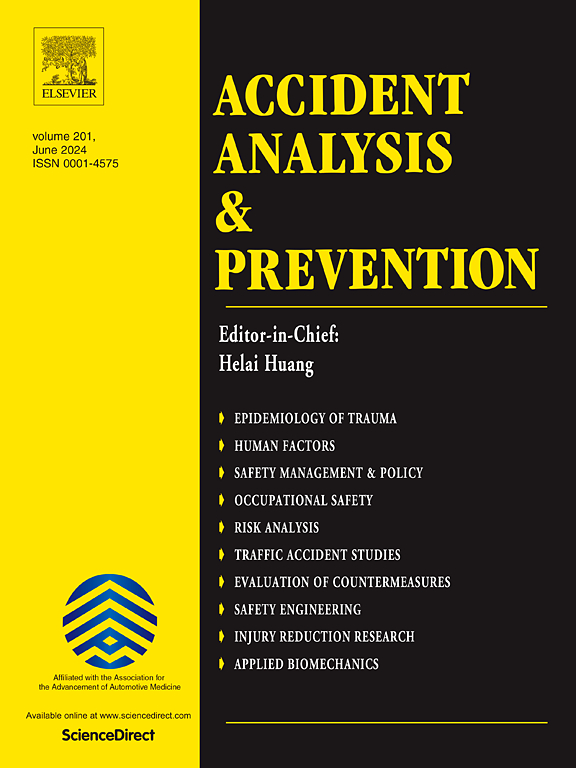老年弱势道路使用者的安全促进因素分析:一般和地方观点
IF 6.2
1区 工程技术
Q1 ERGONOMICS
引用次数: 0
摘要
在空间尺度上认识老年人交通安全与影响因素之间的关系,有必要增加对老年人交通安全的关注。然而,对于某些特定类型的碰撞,在分析单元中存在零碰撞,很少有研究考虑老年人碰撞频率与影响变量之间的空间异质性。为了填补这些空白,本研究开发了一种分析方法,探讨了对老年弱势道路使用者(vru)碰撞的影响因素,特别注意综合综合和局部分析。社会经济、道路网络、公共设施、交通执法和较旧的VRU事故被收集在网格中。采用梯度树增强的Tweedie复合泊松模型(TDboost)从总体上解决了零膨胀碰撞数据。采用地理加权随机森林(GWRF)模型从局地角度揭示空间异质性。结果表明,人口和医疗保健在预测老年VRU事故中起重要作用。主要影响因素对老旧VRU的碰撞表现出非线性效应。它们与老年行人碰撞和非机动车辆碰撞均呈正相关。研究表明,与传统统计模型(如负二项模型和零膨胀负二项模型)相比,TDboost在预测精度和参数解释方面都优于零膨胀碰撞数据和安全因素的复杂影响。VRU事故主要影响因素的局部变量重要度呈现空间聚类趋势和块分布趋势。研究结果为减少老式VRU碰撞事故提供了重要见解。例如,可以针对老年人集中的区域,包括医疗设施、市场和公交车站,进行安全改进。该分析揭示了安全因素对老旧VRU碰撞的非线性效应和空间异质性,这在老旧交通安全研究中通常被忽视。提出的方法强调应根据变量重要性的空间分布来制定改进对策,即“因地制宜”。本文章由计算机程序翻译,如有差异,请以英文原文为准。
Safety contributing factors analysis of older vulnerable road users: General and local perspectives
Increasing attention to older people’s traffic safety is necessary to understand the relationship between their traffic safety and contributing factors on a spatial scale. However, zero crashes exist at the analysis unit for some specific types of crashes, and few studies have considered the spatial heterogeneity between older people’s crash frequency and the influencing variables. To fill these gaps, this study developed an analytic approach to explore the effects of contributing factors for older vulnerable road users’ (VRUs) crashes, with particular attention to the integration of general and local analysis. Socio-economic, road network, public facility, traffic enforcement and older VRU crashes were collected in the grids. The gradient tree-boosted Tweedie compound Poisson models (TDboost) were employed to address zero-inflated crash data from the general aspect. Geographically weighted random forests (GWRF) models were employed to reveal the spatial heterogeneity from the local aspect. The results showed that population and healthcare played an important role in predicting older VRU crashes. Major influencing factors showed nonlinear effects on older VRU crashes. They had a positive correlation with both older pedestrian crashes and non-motorized vehicle (NMV) crashes. This study demonstrated that the TDboost excelled in dealing with zero-inflated crash data and the complex effects of safety contributing factors, compared with conventional statistical models (e.g., negative binomial model and zero-inflated negative binomial model) in both prediction accuracy and parameter interpretation. The local variable importance of major contributing factors for VRU crashes showed a spatial clustering tendency and a block distribution tendency. The findings provided important insights into reducing older VRU crashes. For example, the concentration areas for older people, including healthcare facilities, markets, and bus stops, could be targeted to make safety improvements. The analysis sheds light on the nonlinear effects and spatial heterogeneity of safety contributing factors on older VRU crashes, which are usually disregarded in the older traffic safety. The proposed approach emphasizes that the countermeasures for improvement should be formulated based on the spatial distribution of the variable importance, that is, “adapt to local conditions”.
求助全文
通过发布文献求助,成功后即可免费获取论文全文。
去求助
来源期刊

Accident; analysis and prevention
Multiple-
CiteScore
11.90
自引率
16.90%
发文量
264
审稿时长
48 days
期刊介绍:
Accident Analysis & Prevention provides wide coverage of the general areas relating to accidental injury and damage, including the pre-injury and immediate post-injury phases. Published papers deal with medical, legal, economic, educational, behavioral, theoretical or empirical aspects of transportation accidents, as well as with accidents at other sites. Selected topics within the scope of the Journal may include: studies of human, environmental and vehicular factors influencing the occurrence, type and severity of accidents and injury; the design, implementation and evaluation of countermeasures; biomechanics of impact and human tolerance limits to injury; modelling and statistical analysis of accident data; policy, planning and decision-making in safety.
 求助内容:
求助内容: 应助结果提醒方式:
应助结果提醒方式:


